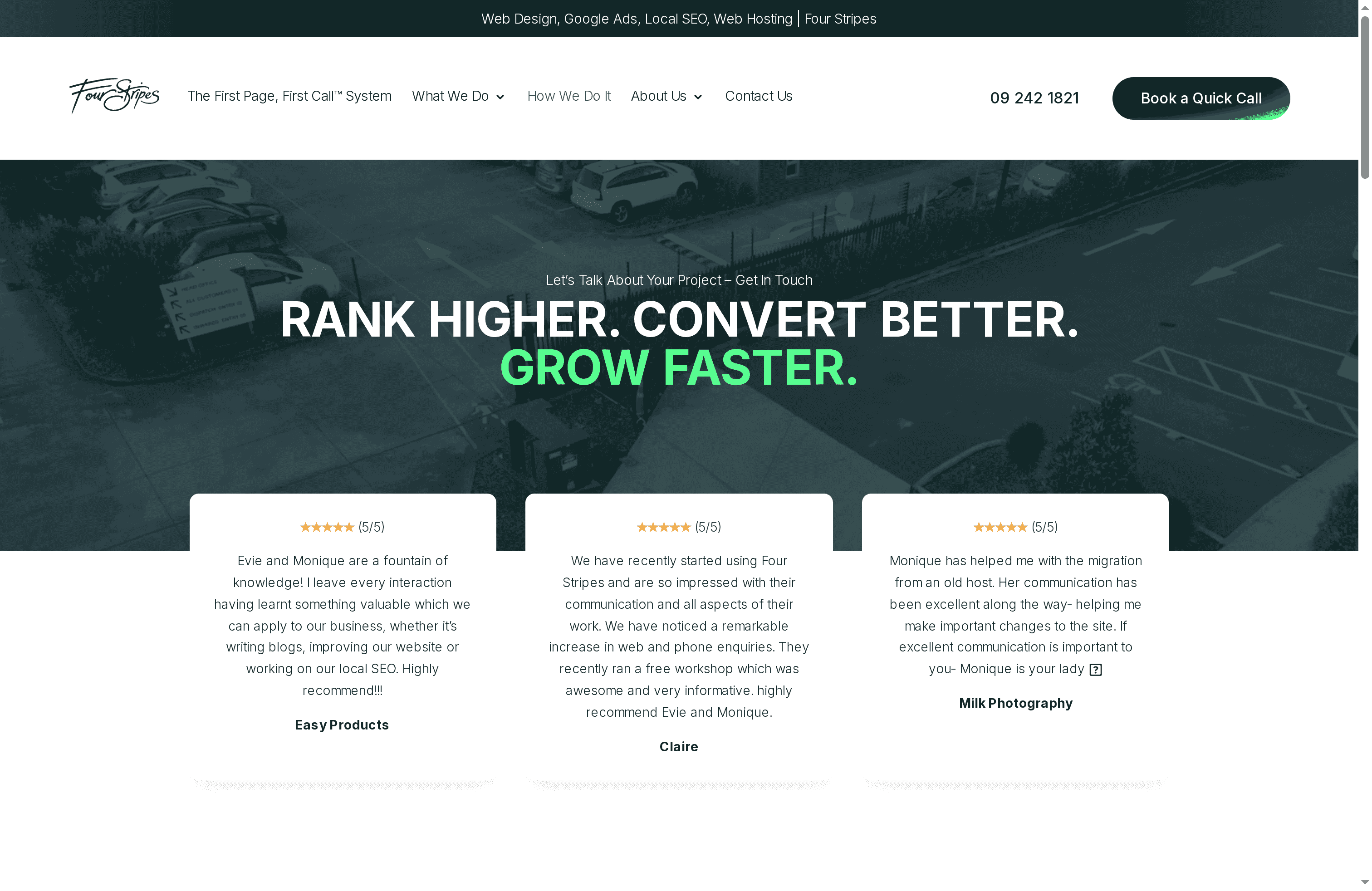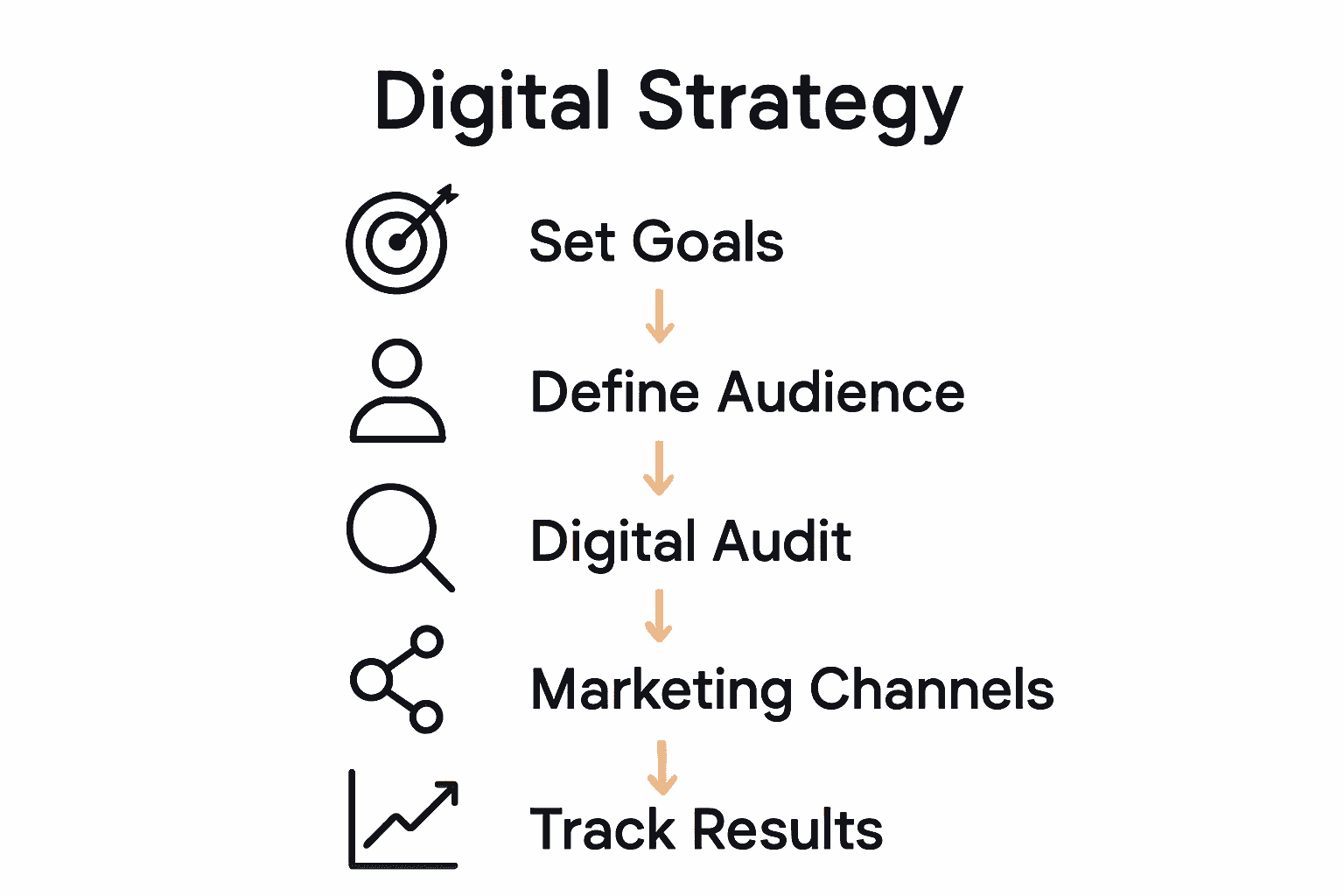Over 60 percent of small businesses lack a clear digital strategy, making it harder to compete and grow online. Without defined goals and a deep understanding of your audience, marketing efforts can fall flat or waste precious resources. This guide breaks down each simple step to help you focus your strategy, outshine competitors, and attract more of the right customers to your business.
Table of Contents
- Step 1: Identify Business Goals And Target Audience
- Step 2: Audit Current Digital Presence And Competitors
- Step 3: Select Effective Digital Marketing Channels
- Step 4: Develop Tailored Content And Local SEO Actions
- Step 5: Implement Tracking To Measure Strategy Impact
Quick Summary
| Key Point | Explanation |
|---|---|
| 1. Define measurable business goals | Establish clear, quantifiable objectives to guide your digital strategy and track success effectively. |
| 2. Create detailed customer personas | Identify your target audience’s demographics, pain points, and behaviors for tailored marketing. |
| 3. Audit your digital presence | Assess your current online platforms and competitor positioning for strategic improvements. |
| 4. Select the right marketing channels | Choose platforms that align with your audience and business goals for maximum impact. |
| 5. Implement tracking mechanisms | Use tools like Google Analytics to monitor performance metrics and adjust strategies accordingly. |
Step 1: Identify business goals and target audience
Creating a digital strategy starts with crystal clear clarity about your business objectives and who you want to reach. This initial step transforms your vague marketing ideas into a precise roadmap for online success.
Begin by sitting down and writing out specific, measurable goals for your business. Are you looking to increase local service bookings by 50%? Generate more website enquiries? Expand into a new geographic area? Your goals must be concrete numbers you can track. For service businesses like trades or local professionals, typical objectives might include growing monthly revenue, expanding customer base, or improving brand visibility in your local market.
Understanding your target audience means going deeper than basic demographics. You want to create a detailed customer persona that captures not just age and location, but their specific pain points, motivations, and online behaviours. For a local tradie or contractor, this might mean understanding what problems your potential customers are trying to solve – like needing urgent home repairs, wanting reliable tradespeople, or seeking transparent pricing.
A helpful strategy is creating a simple customer avatar worksheet. Document key details like:
- Age range
- Income level
- Common challenges
- Where they spend time online
- What social media platforms they use
- Key decision making factors
By combining precise business goals with a deep understanding of your target audience, you create the foundation for a powerful digital strategy that speaks directly to the right people at the right time. Your next step will involve translating these insights into specific digital marketing tactics that will help you reach and convert your ideal customers.
Ready to turn these goals into action? Let’s dive into developing your digital marketing approach.
Step 2: Audit current digital presence and competitors
In this critical step, you will conduct a comprehensive assessment of your online footprint and how you stack up against competitors in the digital landscape. Business NZ emphasises the importance of identifying your unique selling points when planning your online strategy, which makes this audit absolutely crucial.
Start by taking a systematic inventory of your current digital channels. Open a spreadsheet and list out every online platform where your business has a presence such as your website, Google My Business profile, social media accounts, online directories, and review sites. Scrutinise each platform critically. How professional does your website look? Are your social media profiles consistent and up to date? Check the quality of your profile images, business descriptions, contact information, and overall visual presentation.
For competitor analysis, begin by identifying 3-5 local businesses offering similar services. Use Google searches with your primary service keywords to find them. Review their websites, social media engagement, customer reviews, and overall online positioning. Pay attention to what they do well and where potential gaps exist that you could exploit.
 Look for opportunities to differentiate your brand perhaps through more engaging content, faster response times, or more comprehensive service descriptions.
Look for opportunities to differentiate your brand perhaps through more engaging content, faster response times, or more comprehensive service descriptions.
A pro tip is to use free tools like Google Analytics for your website and benchmark your performance. Check metrics like website traffic, bounce rates, and user engagement. For social media, use platform insights to understand your current reach and audience interaction.
By meticulously auditing your digital presence and understanding your competitive landscape, you are setting the foundation for a targeted and effective digital strategy. Your next step will involve using these insights to craft a more strategic online approach that highlights your unique strengths.
Step 3: Select effective digital marketing channels
Selecting the right digital marketing channels is about strategically choosing platforms that will connect you directly with your target audience. This step transforms your broad marketing goals into precise, actionable tactics that drive real business results.
Start by matching your target audience research with the most appropriate digital channels. For local service businesses like trades and contractors, this typically means focusing on platforms where potential customers actively search for services. Google Ads and Google My Business are crucial for local visibility. These platforms allow you to appear precisely when someone in your area needs your specific services. Social media platforms like Facebook and Instagram can also be powerful for building brand awareness and showcasing your work through visual content.
Consider your budget and potential return on investment for each channel. Learn more about effective PPC strategies in our guide to digital campaigns, which can help you allocate resources wisely. Pay per click advertising allows you to target specific demographics and geographic areas cost effectively. For trades and local professionals, this means you can reach potential customers within a precise radius of your business location.
A pro tip is to start with 2-3 channels rather than spreading yourself too thin. Track your results meticulously using analytics tools. Which channels generate the most enquiries? Where are you getting the best engagement? Be prepared to pivot and adjust your strategy based on real data.
Your digital marketing channels should work together like a well oiled machine creating multiple touchpoints for potential customers.
The goal is not just visibility but generating genuine leads that convert into paying jobs. Your next step involves creating compelling content that speaks directly to your ideal customer across these selected platforms.
Step 4: Develop tailored content and local SEO actions
This step is about creating content that speaks directly to your local audience and optimising your online presence to dominate local search results. Business NZ emphasises the critical importance of highlighting your unique selling point when developing your online strategy.
Start by crafting content that addresses your specific customer personas specific problems and questions. For local service businesses this means creating service pages that speak directly to local pain points. If you are a plumber write content about common plumbing issues in your specific region. Include location specific keywords naturally throughout your website. When discussing your services mention specific suburbs or areas you cover. This approach helps Google understand your local relevance and improves your chances of appearing in local search results.
Learn more about local SEO strategies with our comprehensive guide to understand how to optimise your online presence. Focus on creating Google My Business posts that showcase your recent work add customer testimonials and highlight special offers. Include high quality images of completed projects and ensure your business name address and phone number are consistent across all online platforms. This consistency signals credibility to both potential customers and search engines.
A pro tip is to encourage satisfied customers to leave genuine reviews on your Google My Business profile and other relevant platforms. Reviews not only build trust but also significantly improve your local search rankings. Aim to respond to every review professionally whether it is positive or negative showing potential customers that you value feedback and customer service.
By developing targeted local content and implementing strategic SEO actions you are creating multiple pathways for potential customers to discover and trust your business. Your next step involves setting up tracking and analytics to measure the effectiveness of your digital strategy.
Step 5: Implement tracking to measure strategy impact
Tracking your digital marketing performance is essential to understanding what works and where you need to improve. Business NZ emphasises the critical importance of measuring outcomes to ensure the effectiveness of your online business strategies.
Start by setting up Google Analytics and Google Search Console for your website. These free tools provide comprehensive insights into your website traffic website performance and how potential customers are finding you. Pay special attention to key metrics like website visitors conversion rates enquiry form submissions and phone call tracking. For local service businesses the most important metrics are leads generated cost per lead and conversion rate from website visitors to actual paying customers.
Create a simple monthly reporting dashboard where you track your key performance indicators. This might include metrics like website traffic from Google Ads organic search results social media platforms and direct website visits. Learn more about tracking digital marketing performance in our comprehensive guide to understand how to interpret these numbers effectively.
A pro tip is to set up call tracking and recording for your business phone number. Many digital marketing platforms offer call tracking features that allow you to understand which marketing channels are generating actual phone enquiries. This gives you precise data on which strategies are delivering real world results for your business.
By implementing robust tracking mechanisms you transform your digital strategy from guesswork into a data driven approach. You will be able to continuously refine and improve your marketing efforts based on actual performance data. Your next step involves regular strategy reviews and ongoing optimisation to ensure your digital marketing remains effective and efficient.
Take Control of Your Local Digital Strategy Today
Struggling to convert online presence into real local leads is a common challenge for many trades and service-based businesses. This article highlights the vital steps needed to craft a successful digital strategy, from setting clear goals and understanding your audience to selecting the right platforms and implementing local SEO. If you want to stop feeling invisible in your community and start attracting consistent enquiries, it is time to implement proven tactics tailored to your unique business needs.
Discover how expert Digital Marketing can fast-track your journey to first-page rankings and steady inbound calls using our specialised local SEO and Google Ads services.

Take the next step towards dominating your local market with Four Stripes’ customised strategies designed for New Zealand service businesses. Don’t wait until your competitors capture your customers’ attention. Reach out now through our contact page and explore how optimising your Google Business Profile and SEO can generate the leads you deserve within 90 days.
Frequently Asked Questions
How do I start creating a digital strategy for my local business?
To create a digital strategy, begin by defining specific business goals and identifying your target audience. Write down measurable objectives, such as increasing service bookings by a certain percentage over the next quarter, and develop detailed customer personas to understand their needs better.
What are the key components to audit in my current digital presence?
When auditing your digital presence, assess all online platforms, including your website, social media accounts, and online directories. Create an inventory sheet and critically evaluate the professionalism and consistency of your business profiles to identify areas for improvement.
Which digital marketing channels should I focus on for local customer reach?
Focus on digital marketing channels that align with where your target audience searches for services, like Google Ads and social media platforms. Start with 2-3 relevant channels and monitor key engagement metrics to identify which platforms yield the best results within the first few months.
How can I create content tailored to my local audience?
To create effective local content, address specific problems your customers face related to your services. Incorporate location-specific keywords into your website and craft content that provides solutions, such as detailed service pages discussing common local issues.
What metrics should I track to measure my digital strategy’s effectiveness?
Track key metrics such as website traffic, conversion rates, and leads generated to evaluate your digital strategy’s success. Set up a simple monthly reporting dashboard to monitor performance and adjust your approach as necessary, aiming for continuous improvement.

How frequently should I review and optimize my digital strategy?
Regularly review your digital strategy on a monthly basis to assess performance and make data-driven adjustments. Aim to optimize based on real-world results, allowing for improvements in lead generation and customer engagement over the course of several months.
Recommended
- 7 Essential Types of Digital Campaigns for Local Success | Website Design & Google Ads That Generate Leads
- What Is Local SEO? Complete Guide for NZ Businesses | Website Design & Google Ads That Generate Leads
- Complete Guide to Local SEO for Service Businesses | Website Design & Google Ads That Generate Leads
- Hiring a Digital Marketing Strategist in NZ | Website Design & Google Ads That Generate Leads



